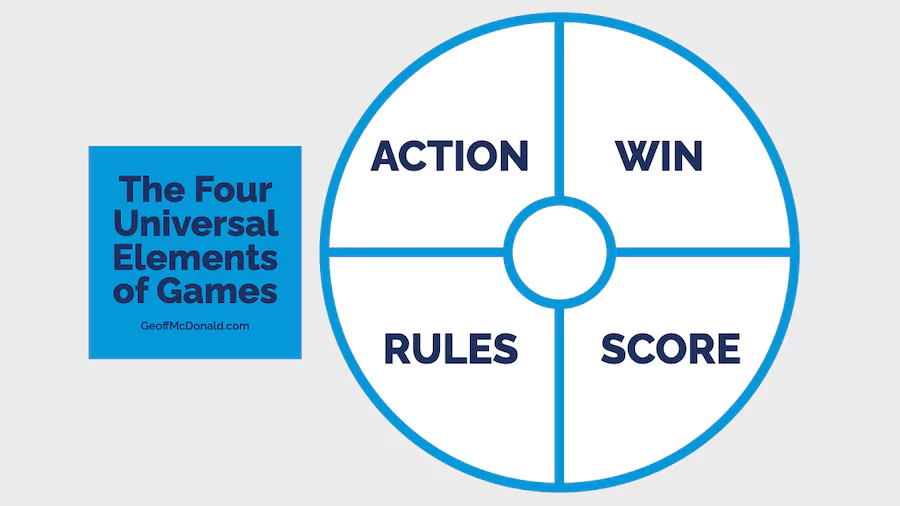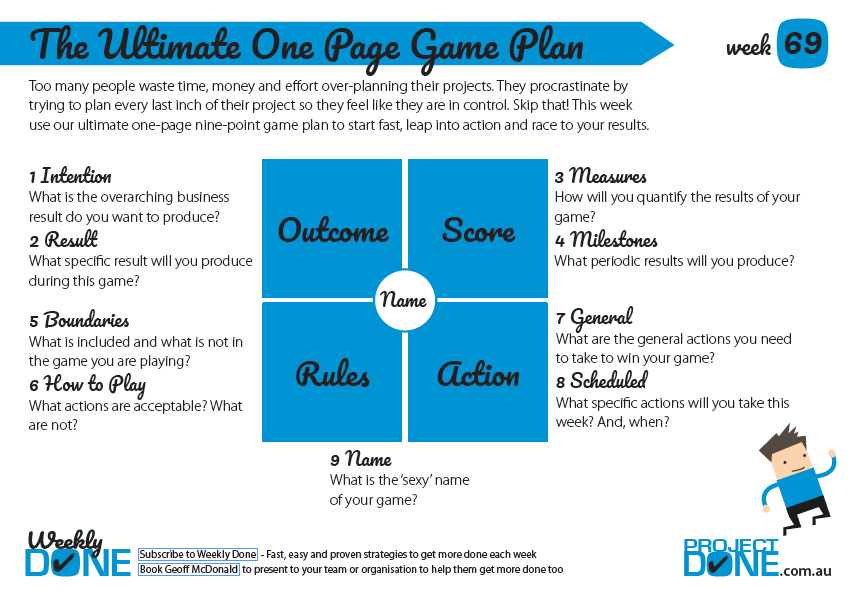What’s the best project planning template for thought leadership content?
Surprisingly, it’s not a project planning template at all. But it is something that people have been doing for thousands of years in every culture on the planet.
Plus, with a little practice, you can use it to define your next project plan on a single page in less than 30 minutes. If you want to get more done in less time, then read on and I’ll show you how.
This is the first post in a two-part series. Today I’ll walk you through the project planning principles. And in the next post, I’ll showcase how I use it for my personal content creation projects.
The best Project Planning Template
I’ve always been great at starting new projects but lousy at finishing them. At one point I had over 25 half-written books on my computer.
After almost going broke from a failed business partnership, I decided I need to address this. I spent the next three years researching how to finish things. During this time, I ran a group training program called Project Done and I wrote three books about getting things done.
The key to finishing things for me was my project plan template. But from all my research, the best project plan isn’t a traditional project plan.
It’s a plan for designing games. Yep, games. And I bet you’re thinking: ‘But this is business, we don’t have time for games here.’
Yes, it is business, but how come between 60-80% of people say they’re not engaged by their work?
And how come you keep looking at your Facebook, Instagram or TikTok account constantly throughout the day?
The Game Design Game Plan
The answer is the same: game design.
At work, your tasks are not designed as games and that’s one big reason why you’re not engaged.
In contrast, social media has been gamed to keep you coming back again and again – and that’s why you do.
If you want to be successful in your career and business, then you must know how to design your work as games so that you can get more done in less time with less effort. And this applies to creating content and becoming a thought leader too.
In this post, I’ll share the four key principles of every game and the nine things you must include in your game plan or project planning template.
And while project plans can be applied to any situation (especially this game design), we will be talking about them relative to achieving your thought leadership and content creation goals.
The Four Essential Qualities of Every Game
Every game must have four essential qualities:
- You play to win
- You keep score
- There are rules to follow
- And you take action.
Sound familiar? Thought so. Now let’s apply this to your project planning template: What specifically would a game design look like when planning your content creation?
How to Win
The purpose of playing a game is to win. Naturally, this means you need to know in advance, how do you win? In your project planning template, there are two types of outcomes or ways to win that you need to consider.
1 Intention
The first outcome is your intention. It’s the broad reason you’re playing your game or project.
- Why are you doing this?
- What’s the purpose of your project?
- Where do you want to be in five years’ time?
For example:
- Why are you creating and publishing content?
- What is the business challenge you want to overcome through creating content?
- Do you want to be recognised as an expert in your industry or niche within five years?
For me, my ultimate goal is to leave a footprint on the planet by sharing ideas that make change happen.
2 Result
How would you know if you were recognised as a thought leader in your industry? There are lots of different ways to measure this. You could:
- Have 1000 people read your blog post
- Be invited to speak at five industry conferences
- Or sell your course to 20 people
For me, I want to attract one million views of my videos. Now that could take a while – but it’s a specific way to measure the difference I’m making.
While your intention is a general direction, your result is specific and measurable. Your result is something that you can count and verify, so you know whether you’ve reached your goal or not.
How to Keep Score
Imagine if you published five posts on LinkedIn but there were no statistics available to tell you which one received the most views or likes.
How would you know which one is the best post? And which post would you write more about?
You need to keep score to know if you are winning or not because if you’re not winning, you’ll want to change your actions to produce better results. And if you are winning you want to keep doing what’s already working for you.
In your project planning template, there are two types of scores you must have.
3 Measures
One of the most powerful ways to stay motivated is to measure your progress towards your goal. The opposite, if you aren’t making progress towards your goal, is demoralising.
The measures you choose need to be tailored to the result you are producing. For instance:
- If you’re writing a book, you can count the words you have written.
- Building an audience on LinkedIn? Then count how many people have joined your group or connected with you.
- For me, I publish one video per week. That’s an easy way to measure my progress.
Keeping score tells us if we are on track to win or not. How will you measure your progress?
4 Milestones
Originally, a milestone was literally a stone marker placed alongside a path that told you how many miles it was to your destination.
A milestone breaks down your journey into smaller bite-size chunks, so you know if you are on track, off track or have lost track.
- If your 60,000-word book is due to be finished in six months, then your monthly milestone or mini-goal is 10,000 words every month.
- If you’re designing your website, you might identify the four key phases of the project and aim to complete one each month.
Your milestones, measures and results should all speak the same language – they should all be measured in related units. Counting the words you write leads to the number of blog posts you publish.
Download the Project Planning Template
To help you achieve your content creation goals faster, download this project planning template. It’s a direct link, no opt-in is needed. Just hit the button and it’s yours.
DOWNLOAD THE PROJECT PLANNING TEMPLATE (pdf)
The Rules of Your Game
When you gain your driver’s licence you agree to play by the rules of the road and this includes stopping at red traffic lights. This is important to ensure that every driver on the road is playing by the same rules. It’s safer that way.
This is one of the big differences between traditional projects and games. Games have rules, but projects generally don’t – especially with regard to defining how to play the game.
In your project planning template, there are two types of rules you must have.
5 Boundary
The first type of rule we have is a boundary rule. It tells you when the game starts and stops.
When you play rugby, you’re allowed to tackle the person carrying the ball. But if you tackled someone who was carrying the ball in the supermarket then you’d probably cause trouble.
The obvious boundary is the end of the game. Are you going to keep playing until you win or when you reach the end of a set time?
Boundary rules can also define what results to count. Are you counting how many new email subscribers, YouTube subscribers or both?
6 How to Play
The second type of rules is the rules of play. They define acceptable behaviour.
Remember, to include both what’s okay as actions within your project and those which aren’t.
- If you were creating content for LinkedIn, do you have to create original posts or can you simply reshare someone else’s post?
- In my YouTube game, I have a rule that says every video must have a new element in it – something I haven’t done before. This might be to add a sound effect for the first time or a piece of b-roll footage.
You might also have rules about who is on the project team and what their roles are. For instance, on a blogging project, you might have a writer who creates a post and an editor who reviews and approves it.
The Action to Take
If you want to win our game and complete your project, there is one thing we all must do – take action. The best project planning template in the world (this one!) is worthless if you don’t act on it.
The big question is: what type of action is going to be best?
Defining what actions will win your projects is a crucial part of your project strategy. There are two main types of action you need to take in any game.
7 On-Field
When you play sport, the main action happens on the field. It’s people running around, jumping over things, hitting balls, and tackling each other.
In your projects, your actions are more likely to be thinking, creating, writing, designing, and talking with other people.
The key actions are the critical ones. And critical is defined by: If you don’t take this action, you can’t win your game.
For me – if I don’t create a video, I can’t publish it. That’s critical. But if I don’t have b-roll or images, I can still publish a video. I want to include that, but it’s not critical.
8 Off-Field
The opposite of being on the field at a sporting event is sitting in the grandstand and watching. But for the game players, the opposite of being on-field is the preparation you do before and after the game. This might include stretching, gym training, eating well and getting a good night’s sleep.
For your game, think of the actions you need to take to get ready to perform at your best when you step on the field.
Most content creators don’t prepare in this way. And we spoke about this in an earlier post as one of the three big mistakes too content creators make.
For me, my off-field actions for my videos include reading books and watching other videos. This helps me improve and create better videos. Plus, once I publish a video, I always do a review so I can learn what worked and what didn’t.
9 Name
And finally, you need to call your project or game something. If you pick the right name, you can make it easier to win your game.
I could call my video project, Geoff’s Video Project. But that’s boring! No inspiration there.
If I revisit my intention then I can see that my goal is to leave a footprint and make change happen on the planet. This suggests some great names:
- The Footprint Game
- The Change Game
- Or simply, Inspire
What name could you give your project to inspire you every day?
More on creating your Project Planning Template
The best project planning template is based on the universal principles of game design.
If games are universal to the way we learn and play in every culture on the planet, then using them to create and complete our projects is a great strategy. They’re perfect for you to create a content creation project to build your thought leadership. And you can use it to get more done in less time for any business or career project.
In our next post, we’ll go into more detail as I apply this project planning template in a practical example. I’ll be sharing the game I’ve created for myself using this exact project planning template so you can see how it works in action.
Until then here are three related posts you might like to read to deepen your learning:
- Content Creation Process – Three Big Mistakes People Make
- IP Creation Projects for Thought Leaders
- The four levels of Purpose for Business Experts and Thought Leaders
Which of the nine project planning elements appeals most to you?





